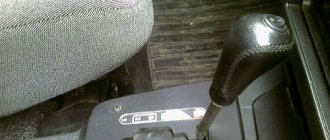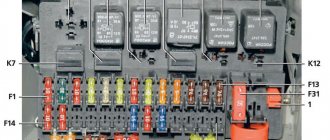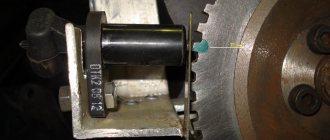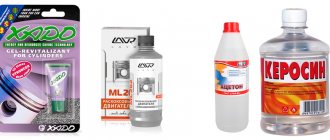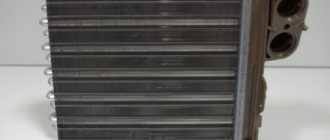Good afternoon The 2.4 engine stalls when accelerating, it feels like the ignition is late. Help me please! (Magamed)
Hello, Magamed! There can be many reasons for this, ranging from compression and spent spark plugs to the fuel filter. Of course, the problem may also be late ignition. If you had indicated the make of your car, perhaps our recommendations would have been more accurate.
Why does a car accelerate poorly?
Vehicle performance can be degraded due to many factors.
Below are the main reasons why an engine accelerates poorly:
- Incorrect motor operation. This may be due to a decrease in the compression level in one or several cylinders at once. In addition, the problem may be the leakage of additional air into the engine intake tract. Often the dynamics are disrupted when the intake system becomes coked or when the exhaust gas converter breaks down.
- Incorrect operation of the power system. If the fuel filter element or injectors are clogged. The fuel supply pipes may also be clogged. In some cases, problems are caused by insufficient fuel pump supply or the use of low-quality gasoline.
- Problems with the ignition system. When spark plugs have expired or there is a breakdown in high-voltage wires. A check needs to be done.
- If the sensors of the engine control system fail. For example, if one of the regulators breaks down, the ECU begins to function according to an additional backup program. Such a program is launched so that the motorist can get to the service station or garage. At the same time, the economic and power parameters of the motor are significantly reduced.
- When the clutch slips, which often occurs as a result of misadjustment or wear. A thorough diagnosis of the mechanism should be carried out.
- Insufficient air pressure in the tires. It is necessary to check and, if necessary, bring the pressure level to the required level.
- Also, deterioration in dynamics may be due to vehicle overload.
- Incorrect operation of the braking system, which may be caused by the wheels braking while driving or incorrect adjustment of the hand brake. There is a diagnostic option. You need to find a smooth road, preferably one where there is no wind during the test.
The point is to carry out a run-down run of the car. Refuel the vehicle; only you should be inside the car. The car accelerates to 50 km/h, after which the neutral gear is engaged and the car drives until it stops on its own. A similar procedure is repeated one more time, only in the opposite direction. You need to measure the car's run-out based on driving in both directions; on average it should be approximately 0.5 km.
Tuning an injector with 8 valves
[custom_ads_shortcode2]
To increase power from 77 to 96 horsepower of the very first engine of the VAZ-2111 model, you need to do:
- boring valve seats along the inner diameter;
- boring the channel necks for installing duralumin plates and loosening the springs by 1.5 millimeters;
- replacing standard valves with lightweight ones;
- recessing of guide bushings from special brass;
- installation of a split timing gear;
- use of imported valve cotters;
- installation of a narrow-phase shaft.
The tuning shaft has an inlet of 70 degrees and an outlet of 66. Its opening angles are 250 and 246 degrees, respectively. After completing the work, it is necessary to install the engineering firmware and carefully configure the motor parameters. Only in this case, after all sensors are turned on, the engine will start working normally.
[custom_ads_shortcode1]
It is better to use a split gear on non-plug-in motors. For installation, it is necessary to carry out the work in almost the same way as when replacing the timing belt, that is, apply marks, disassemble the mechanism, and align the crankshaft. After installing the new gear, pay attention to the 4th cylinder. If the valves in it are not open to the maximum, in this case you will need to loosen the outer screws and adjust the camshaft, after which you need to tighten the fasteners.
Video “How shock absorbers affect the dynamics of a car”
For details on how shock absorbers affect car acceleration, watch the video (video author – KYBRussia).
It's very slow when accelerating. if the pedal to the floor begins to gain momentum even more slowly, and accelerates longer, and a little (press the gas pedal) faster, but still thinks and then drives .. but not briskly ((tell me what to pay attention to. 6000 thousand ago I changed absolutely everything filter, cleaned the injectors, excellent compression, adjusted the valves, etc. tell me what the x is.
Sometimes motorists are faced with such an infrequent, but extremely unpleasant phenomenon as failures when pressing the gas pedal on the injector of a VAZ 2114. In short, such failures are the lack of a quick response from the car engine to pressing the gas pedal. We will talk about why they can arise and how to eliminate them on your own in today’s article.
The main mistakes made when tuning
[custom_ads_shortcode2]
Many people try to add power to the engine, but at the same time make typical mistakes. The leading ones among them are:
- installation of cutters in garage conditions (this work requires high precision);
- use of unnecessary and expensive spare parts;
- lack of suitable firmware for a sports camshaft or other elements.
Before buying expensive spare parts, you should pay attention to the recommendations of the specialists. They created a list of useless components:
- A receiver with an increased volume is good only at medium and high speeds, but for work in the range from 1000 to 2500 rpm, a standard spare part is more preferable.
- A zero filter, called a “chandelier,” is a fairly useful addition, but you will have to constantly clean it with special chemical compounds. This will increase the cost of maintaining the car.
- A throttle valve of increased diameter does not increase power too much, since the engine always has enough air.
Features of failures
What all pedal failures have in common is that when you press the pedal, the engine does not respond in a timely manner, and therefore does not gain momentum. Such failures can appear in different situations and the behavior of the machine can also be different.
So, we can highlight:
- Short dips while driving (no more than a couple of seconds) followed by a quick response from the engine.
- Dips during acceleration.
- Dips at idle speed.
- Prolonged failures, as a result of which the car stalls.
- Jerking, characterized by a series of alternating short dips and subsequent jerks.
There are not many reasons for this phenomenon, so finding and eliminating them will not be difficult for an experienced driver.
In 99% of cases, failures can be caused by one of the following reasons:
- clogged injectors;
- damage to the fuel system;
- injector damage;
- wear of temperature sensors;
- errors in the ECU;
- failure of spark plugs.
If you notice even minor changes in the “behavior” of the engine, you should end the trip as quickly as possible and visit a car service center or perform independent diagnostics and repairs. Continuing to drive a car with dips is not only harmful to the car itself, but also extremely dangerous.
What engines were installed on the VAZ-2114
The very first engine used on the VAZ-2114 was an injector with 8 valves and a volume of 1.5 liters. It is one of the most common on this car model, as it was installed on the VAZ-2114 for 6 years. Their series was designated: VAZ-2111, units with it had a rather modest power of 77 “horses”.
In 2007, the production of the “fourteenth” models was modernized, which gave motorists an updated engine. It had 16 valves and a larger volume of 1.6 liters. The series of this engine is VAZ-11183-1000260.
In addition to more modern characteristics, this power unit has received the Euro-3 environmental standard. However, engine power increased only in 2009. The first versions of this engine were with 77 hp. With. , and then their strength increased to 89.
In 2010, the VAZ-2114 again received a new engine. It had 8 valves and a volume of 1.6 liters, exactly the same one was installed on the Priora. Significant modifications to this engine helped it reach 98 horsepower.
Many car enthusiasts were interested in why modifications with 16 valves stopped coming off assembly lines. The need to change the power plant was associated not only with an increase in power, but also with the fact that when the timing belt broke in the previous model, the valves were bent.
What all powerplants have in common is that they use the same fuel injection system. Before entering the cylinders, the fuel passes through the nozzles in all modifications, and the installation is cooled using liquid. Well, the last similarity is that all units are four-stroke.
On-site testing
The final stage of testing is exercises on the site. The maximum value of lateral acceleration that was achieved under the desperate sounds made by Chinese tires was 0.84 g. At the same time, the car tries to fall into an uncontrolled skid, and when the gas is released, the Lada returns to the given trajectory without much difficulty.
Maximum lateral acceleration value
The electric power steering, or rather, its shortcomings, again reminded itself when performing the “snake” exercise. This time the cause of the problem was too much effort, which is not easy for even men to cope with, let alone women. It is unlikely that a fragile girl will be able to quickly perform a counter-emergency maneuver with such EUR settings.
In the end, the only thing that really pleases is the noticeable progress of VAZ. Be that as it may, the second generation Lada Kalina is no longer the usual “Zhiguli”, although this car still requires significant improvements. Of course, many car enthusiasts would like to see more significant progress, but in this case they should be patient. Domestic manufacturers have something to strive for, and the fact that they are trying to improve their lineup speaks volumes.
What does the initial acceleration depend on?
The traction force of the Priora depends on the gear ratio in the gearbox, the so-called transmission. The latter consists of a clutch (the connection between the gearbox and the engine mechanism), drive shafts and a gearbox, which transfers power and torque from the engine to the wheel shafts. Gear ratios can be of: 2 types.
| Gear ratio | Description |
| Short | many teeth on gears |
| Long | small number of teeth |
If you need quick acceleration to 100, then use gear ratios with a short ratio.
Lada dashboard
In addition, the Lada can accelerate faster if the number of the main pair is increased (for this family the standard number is 3.7). It is believed that setting the pair to 4.1 or 4.3 allows you to get a noticeable (but is it necessary) advantage for breaking away at a traffic light, and sports models are equipped with modifications with numbers 4.7 or 5.1 (for crossovers). Cars used in urban environments, where acceleration to 100 is not necessary, are equipped with a gearbox with a balanced series of gear ratios, which does not provide rapid acceleration, but provides high speed, if necessary.
It is worth remembering that not every Priora will withstand the load from additional numbers for a long time with a standard clutch. That is why when tuning you need to install more durable and reliable components that are produced by AP LockheeD or “Luk”. You should also think about purchasing high-stiffness springs and cermet discs for the clutch basket. In addition, to reduce the load on the clutch, crankshaft and gearbox, you can install a lightweight flywheel for the Priora, which is on average 2-3 kilograms lighter than the standard one (additional fuel savings). But experts do not recommend lightening the crankshaft, because in a garage, or even most car repair shops, it is impossible to select balancers for the connecting rod journals for a new shaft, which can lead to the collapse of the entire system.
Lada Priora has a slower acceleration to 100 kilometers per hour than, for example, a rear-wheel drive model with the same engine characteristics, since the basic configuration of this car is not intended for sports. Therefore, it has a lighter torque transmission design and no cardan, which adds greater controllability and efficiency to this urban car.
Gasoline consumption
How economical is the Lada Kalina 2, equipped with an automatic transmission? There is no single answer to this question, since driving on city streets is extremely unpredictable, especially given the constant traffic jams. It may also happen that even 15 liters per 100 km is not the limit, although on average a car consumes no more than 12 liters per 100 km.
However, leaving the city puts everything in its place: covering tens of kilometers on the highway at a speed of 110 km/h showed fuel consumption not exceeding 8 liters. Moreover, if you drive at a speed no higher than 90 km/h, the consumption will be less than 7 liters.
Unfortunately, it is worth noting that it is not the cheapest 95-octane gasoline that needs to be filled into the fuel tank.
Read more about testing in different weather conditions
On snow-covered city streets, you should pay more attention to sharp or dynamic maneuvers, namely acceleration and braking, since the car constantly strives to deviate from the intended course.
For the sake of fairness, it is worth noting that it does not come to dangerous situations: as soon as the car changes its trajectory, electronic assistants (ESP or ABS) are activated.
The dynamic stabilization system prevents slipping of the drive wheels, albeit with some delay, as does the anti-lock braking system, which allows the wheels to lock, albeit briefly.
Lada Kalina 2 is equipped with ESP and ABS
On a track covered with snow and ice, it becomes much more “fun”: you have to take into account not only the delayed response of the electric booster to the turning angle, but also the slipping of the tires. As a result, any lane change turns into an attraction to maintain optimal balance, since the steering wheel cannot be left motionless even for a moment.

